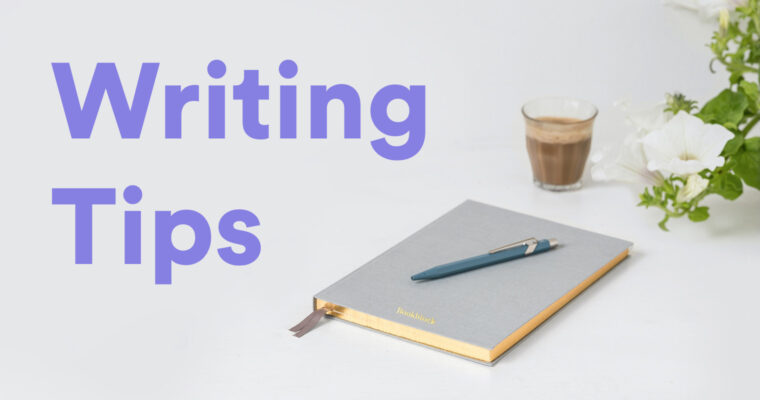
Every day, you write, whether it’s a college paper, blog post, work document, email, or social media update. Your writing represents who you are personally and professionally, so it’s worth it to hone your skills. Here are thirty writing tips to help you communicate better in text.
30 Writing Tips to Help You Get Started
1 Set writing goals.
Maybe you want to write a certain number of words per day or upgrade your vocabulary. You can’t reach a goal unless you have one, so write that goal down and work toward it.
2 Write in the morning.
For many people, writing comes easier right after a good night’s sleep. Grammarly’s research also shows early birds make fewer writing mistakes. (No matter when you write, Grammarly has your back. Try Grammarly to get more writing tips to help keep you on track.)
3 Write daily.
Getting started on a big writing project can feel intimidating if you’re not used to the act of writing. Practice this skill daily—whether a short sentence or full paragraph—to get accustomed to the mental and physical concept of writing.
4 Get inspired by research.
Before you begin writing, do some reconnaissance reading. Take notes as you read up on your subject material. Ideas will form as you research.
5 Always carry a notebook and pen.
Inspiration can hit you at any time. Don’t leave a gripping pitch for a client, poetic sentence, or catchy project name to your memory. Write it down in a dedicated notebook, or create a note file on your smartphone.
6 Experiment with writing prompts.
One of the best writing tips for aspiring writers is using a prompt. You can find endless writing prompts online that are suited for all types of genres. Pick one that stimulates your imagination and encourages you to get creative.
7 Outline.
If you often find yourself rambling on without a clear structure, start with an outline. Follow this simple, no-fail outlining process to organize yourself from the start.
Writing Tips for Email and Other Professional Documents
8 Keep it brief.
Brevity is important in professional communication. Respect your colleagues’ time by knowing exactly what you need to communicate before you begin writing so you can keep your message concise.
9 Use active voice.
Writing in active voice animates your writing so that the subject is acting on its verb. An active voice reads as being more confident and self-assured; it’s also a great way to shave superfluous words from your writing.
10 Don’t neglect context.
Does the person you’re communicating with have the same information and frame of reference you do? If not, make sure you provide context. You don’t have to give the entire backstory, just fill in the missing pieces so your message will be clear.
11 Format your email properly.
Use good email formatting structure. Write an enticing subject line so your recipient is compelled to open your email. Understand proper email salutations and closings.
12 Don’t email angry.
Yes, you might be irked at your colleague for dropping the ball on that project and making you look bad, but don’t send emails when you’re still fuming. If you must write when emotions are hot, do it offline. Walk away for at least twelve hours, then edit with a calm head.
Grammarly’s tone detector can help you moderate your tone when you do come back to your keyboard. Get helpful writing tips and assessments of how your writing sounds to your recipient.
13 Proofread thoroughly before you hit SEND.
Typos and grammar gaffes make you look bad. Scan your email and fix errors before you send it. You’ll look your best when your correspondence is mistake-free!
Writing Tips to Help You Sound Natural
14 Write like you talk, within reason.
Your writing should sound natural and fluid. Unless you’re communicating in a more formal context, write as though you’re talking to a friend.
15 Don’t ramble.
We just said “Write like you talk”, but there’s a caveat—don’t ramble. Avoid winding twists and turns, and don’t use filler words such as like, really, and you know. Good writing should get to the point and avoid fluff.
16 Be a storyteller.
No matter what the message is, we humans are drawn to stories. Consider Pixar’s guide.
Once upon a time there was ___. Every day, ___. One day ___. Because of that, ___. Because of that, ___. Until finally ___.
—Pixar’s Rules of Storytelling
17 Empathize with the reader.
Empathy can improve all kinds of writing, from fiction to content marketing to email outreach. Take the time to put yourself in your reader’s place. Are you preaching to them, or are you engaging them by showing that you relate to their feelings and experiences?
18 Be fascinated in order to be fascinating.
The more interested you are about the subject you’re writing about, the more intrigued your readers will be with what you’ve written.
Clean Up Your Writing With These Writing Tips
19 Let your writing rest for a while and edit fresh.
Whenever possible, don’t edit just after you’ve finished writing. Come back after a break and review with fresh eyes. Even stepping away for a quick walk or a cup of coffee can help you shift gears from writer to editor.
20 Get rid of filler words and phrases.
When you edit, it’s time to cut the fluff. Every word needs a job, and those that aren’t pulling their weight have to go. Here’s our list of words and phrases you can eliminate right now.
21 Avoid cliche.
As you’re reading through what you’ve written, look for overused phrases that can be recast in a fresh and unique way. It’s one of the most common writing tips, but also one of the most ignored.
22 Dump adverbs.
Get rid of most adverbs and use stronger verb choices instead. When you do, ran swiftly becomes darted and cried pitifully becomes wailed. Remember what Stephen King said: “I believe the road to hell is paved with adverbs.”
23 Develop your comma mojo.
The comma is a misunderstood punctuation mark. There are many rules for proper comma usage, but if you study them, they’ll become second nature. Here’s a quick guide. And here’s another that lists the most common comma struggles and how to solve them.
24 Put everything in the right order.
We often write in the order that ideas and thoughts come to us, but that’s not always the best way to present the final product.
25 Read your writing out loud.
One of the best ways to find clumsy sentence structure is to read your writing aloud. If you stumble as you’re reading, take a look at the sentence you tripped over and see if you can clear it up.
26 Keep a list of mistakes you make often.
We all have our writing struggles. Make a list of your most frequent mistakes so you can easily find and eliminate them next time.
27 Think about your ideal reader.
As you write, think about what your ideal audience or reader knows today. What is their reality and how can your writing inform and enhance it?
For example, if you’ve written a how-to guide on fixing boats, does it start at the same level of knowledge as your ideal reader’s skill level? It’s important to know where your reader is in their journey so your writing doesn’t lose them along the way.
28 Enlist a friend to read your draft.
Sometimes a second pair of eyes can prove helpful. Just remember the mnemonic, TWYWALTR—in creative circles, it means Take What You Want And Leave The Rest. Give all the advice you receive your full consideration, but make your own choices in the end.
29 Get a hand from Grammarly.
Editing yourself is hard. Grammarly’s app can help you find all kinds of writing errors. Think of it as a helpful friend looking over your shoulder, giving you writing tips and saying, “Hey, that doesn’t seem quite right. Want to take another look?”
30 Keep reading, learning, and practicing.
Read about writing to get more writing tips. (You’re here, so you’re off to a good start!) Read widely, and you’ll learn writing tips by osmosis. And practice often. The best way to improve your writing is by doing it. And if you need a distraction-free writing space to practice, Grammarly has your back.
More from Grammarly:






